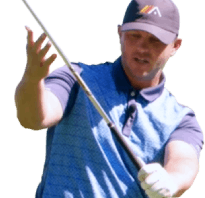How To: Dramatically Boost Your Swing Speed by Eliminating the 4 PROVEN Speed Killers
BY SHAUN WEBB AND MIKE GRANATO, ATHLETIC MOTION GOLF | April 15th, 2021
Uncovering the 4 PROVEN "Speed Killers"
What needs to happen in your golf swing to generate more swing speed so you can generate more ball speed and more distance?
In this post we’ll show you some of the moves that you may be trying to do that are actually HURTING you from gaining speed, and we're going to reveal the exact things you need to be doing to get more speed in your swing.
SPEED KILLER #1 | FROZEN TAKEAWAY
Let's just start from the bottom.
Having no lateral motion starting back, like trying to NOT sway at all as you start your swing is a huge speed killer.
We see the image that golfers have in their head is, “I don't want to have motion all over the place and feel out of control…”
This turns into the player thinking they're keeping the center of their belt buckle right where it needs to be – but in reality, this concept will cause the hips to move forward (toward the target) as the swing starts.
That is 100% of speed killer.
If you're trying to hold your hips completely still laterally as you start the backswing – you're leaving out critical motion that can actually help you get things moving in the right direction.
SPEED KILLER #1 | FROZEN TAKEAWAY
Let's just start from the bottom.
Having no lateral motion starting back, like trying to NOT sway at all as you start your swing is a huge speed killer.
We see the image that golfers have in their head is, “I don't want to have motion all over the place and feel out of control…”
This turns into the player thinking they're keeping the center of their belt buckle right where it needs to be – but in reality, this concept will cause the hips to move forward (toward the target) as the swing starts.
That is 100% of speed killer.
If you're trying to hold your hips completely still laterally as you start the backswing – you're leaving out critical motion that can actually help you get things moving in the right direction.
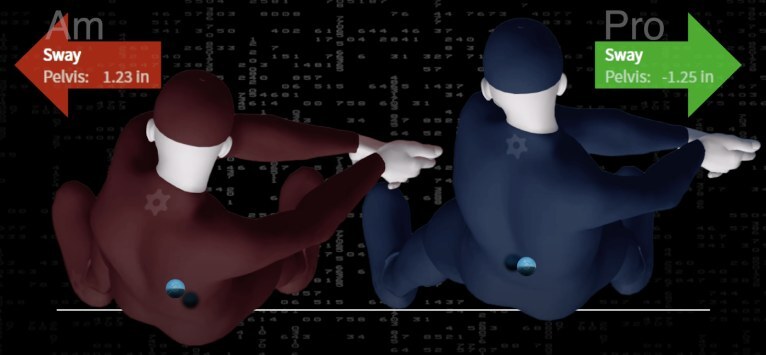
Shown above are REAL swings from an Amatuer on the left in red, and a Tour Pro on the right in blue.
The ‘sway’ numbers you see here at the top are showing you real-time location information of where each call for the center of the pelvis is moving.
A positive number means the pelvis is moving laterally TOWARDS the target – while a negative number means it's moving laterally AWAY from the target.
Here, we're using these small rotating balls (shown above in blue) to track each golfer's center of pelvis movements so you can see where they start and where they move to.
And finally, we put a thin white line behind their left heels. If you've seen our Pros vs. Ams content on hip rotation and early extension, you know how important it is to not have a lot of your rear end behind this line!
Our Amatuer is in a very prototypical amateur setup with a lot of his seat behind that line, that's going to create an issue for him right off the bat.
As these guys start moving, you're going to see two completely different movement patterns – ones we see every day as we’re teaching.
The Pro is moving his pelvis to the right or AWAY from the target as he rotates back, while the Am is moving his pelvis forward as he rotates back.
We're only taking these guys to the end of their takeaways, or when the club shaft is parallel to the ground.
At this spot, our Pro here is right on a Pro average of about 1.2 inches of movement away from the target – contrary to our Am who has also moved 1.2 inches, but he's moved in the complete opposite direction.
Anytime there's an opposite movement from what good players do, it's something you'll probably want to correct!
Because our Am was told that sliding was bad and he should avoid that at ALL costs – he thought (and felt) he was turning with a centered pivot. He felt he was turning around the middle of his hips, but as you can see that wasn't the case moving laterally in the golf swing.
Whether you want to call it sliding swaying lateral movement, it is not bad. It's about when it's done and how much it's done. That's what creates the issues. As with many other things – anything good can be overdone.
THE FIX:
So here's a great way to know if you're moving correctly to start your swing, placing an alignment stick outside your right leg – leaving a two-inch gap between the stick and your hip/thigh.

Swing wing the club to the end of your takeaway. When the shaft is parallel to the ground, if your hips have moved away from that alignment stick, you're moving your pelvis in the wrong direction.
Instead, as you turn you want to see your right hip move into that stick a bit before the shaft is parallel to the ground – then move back to where you started as you complete your swing as we’ll show you in the Before/After images below:
Shaft Parallel:
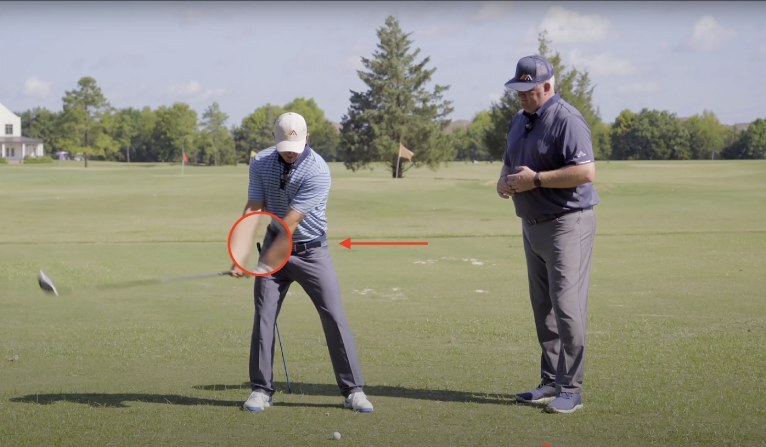
Doing this correctly will help set up your backswing for a dynamic and athletic downswing that naturally generates more swing speed.
SPEED KILLER #2 | PUTTING YOUR KNEES IN A CAST
This is one that we both did when we were younger players – and we know now the only thing we’re left with are bad backs because of it…
Shaun had a guy who was helping him with his swing when he was younger – he wasn't an instructor, but he was a REALLY good player. When you're younger and you go find the best player at the club, and you get help from him.
You think it's gold, right?
He told Shaun to envision both of his knees locked in a cast. He was pretty darn athletic when he was younger and he could do that pretty easily…
Imagine if Shaun had put a shaft down across his knees to keep them in place… he was trying to not change the knee flex at all with either leg – which we know now is just dead wrong.
Trying to hold your lower body still while crank the upper body back with rotation – is most likely going to get what we just saw in Number 1 – the hips are going to turn level and move FORWARD instead of away from the ball.
That's going to tilt the upper body back – and you're gonna get in a world of hurt as far as generating speed – and maybe even a world of hurt as far as pain goes.
Despite being a simple and straightforward movement – knee bend is something we see cause problems for both Pros and Amateurs, when and how much the knees bend has a big influence on what happens with your upper and lower body throughout the swing.
Let’s take a look at what happens in a good knee bend pattern.
Address:
Address:
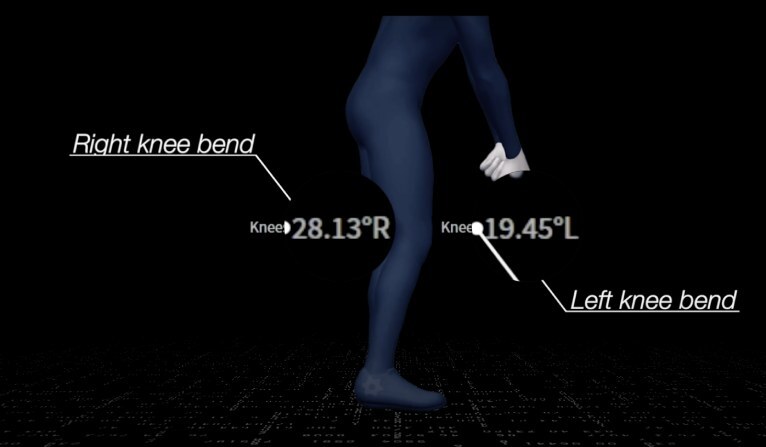
Top of Swing:
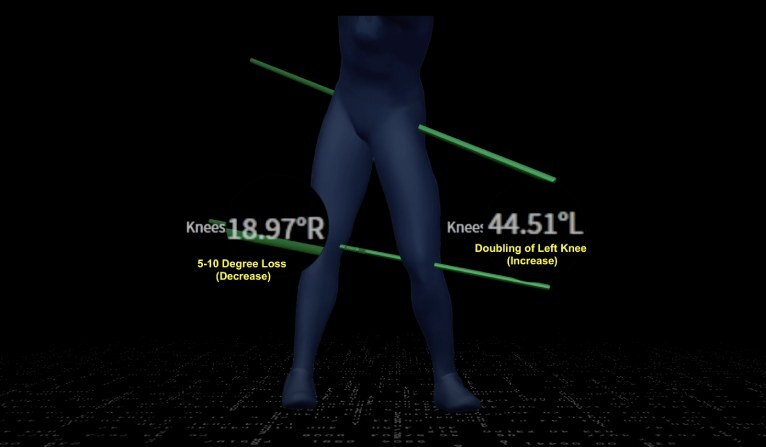
Our Pros we see start changing their knee bend immediately in the swing – to the levels you see in the picture above – straightening that right leg up while doubling the flexion of the left knee.
Often, Amateurs struggle trying to hold their knee bend until late in the backswing, which isn't something we see in great swings.
By the time our Pro reaches the top of his swing, his right knee is lost around 10 degrees of bend while his left knee has more than doubled.
We typically like to see a five to 10 degree loss in right knee bend with at least a doubling in the left knee.
The reason for this is it creates a TREMENDOUS advantage for you in the transition.
When your right knee straightens, it raises the right hip, when the left knee doubles its bend – it lowers the left hip. That combo puts you in this powerful downhill position at the top, which allows you to really leverage the ground in your downswing for a SERIOUS boost of speed.
Try it for yourself:
Take a backswing and allow your lead knee to double in flex from where it started. Also let the trail knee lose a little bit of flex as you take the club to the top.
Address:
Left (Front) Knee: 21.95 | Right (Trail) Knee 24.99

Top of Swing:
Left (Front) Knee: 43.45 | Right (Trail) Knee 22.91
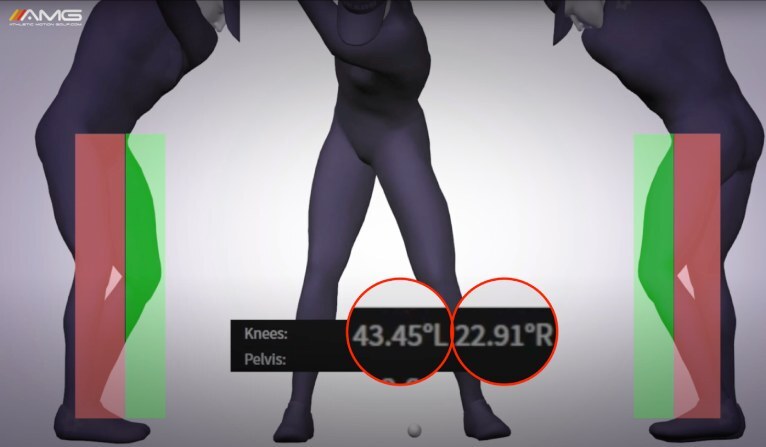
Change: Left (Front) Knee: +21.5 | Right (Trail) Knee -2.08
Once you do this you will notice that the trial hip is higher than the lead hip.
Learning to bend your knees correctly will allow you to create a dynamic start to your downswing, which is a great and easy way to add a bunch of speed to your swing.
SPEED KILLER #3 | MAXED-OUT TURN
Overturning in the backswing – aiming for unlimited turn at all costs, turning your body as much as possible – is a major swing killer.
What the golfer normally does – as they try to max out their turn – is they stand up out of their posture, releasing all of their body angles in the swing.
They're losing all these great kinds of hip tilts and body tilts that they need to make a decent golf swing.
So by trying to do that, to get more speed, not only are they ruining the motion or the plane of their swing, they're going to slow down because it takes too much time to get back to the ball and squared up in time for impact.
It’s almost like robbing Peter, and you got to pay Paul, Mary, John, and Tim in a quarter of a second on the downswing.
With a quarter of a second, you have to complete the downswing – you always wind up short.
A good range of motion and rotation in the golf swing is 80 degrees. Most normal golfers are somewhere around 70, a few really flexible young flat-belly Pros are around 90 degrees.
A conservative range is 75 to 85 degrees of rotation that needs to be made up for in a quarter of a second of that downswing.
There are golfers in their sixties and seventies, in some cases, showing 60 to 65 degrees of rotation, and because they're standing up, they got the club wrapped around them.
They think this is going to be speed, but the problem is, you can't cash in on it by impact because your body can’t get back to the impact position it needs to quick enough – which often results in a ‘flip’ or ‘scoop’ at impact as the hands try to compensate.
The other issue when you “over-turn” on the backswing is that you lose a good connection to the ground with your feet. If you lose that connection with the ground, the downswing will feel like you're trying to start your car in 5th gear…a sluggish, stalled move in transition, instead of the explosive one that you will need for maximum speed.
There is a way to turn correctly that you can still feel like you're making a big enough turn, while also putting a body in the right position to do it that is so much more valuable to generating speed. So it’s time to scrap the idea of just maximum rotation for maximum speed.
That's not how it happens.
When studying the swings of some of the fastest players in the world, it became clear that having balanced rotation is a necessary element in any swing.
By balanced, we mean that if you rotate 80 degrees on the way back, you should be able to equally rotate that 80 degrees on the downswing.
Most players fall short of this – thinking that they are doing themselves a favor by having a huge wind-up, but they’re seldom in a position to equate that same rotation in their .25 second downswing – costing them major speed and distance.
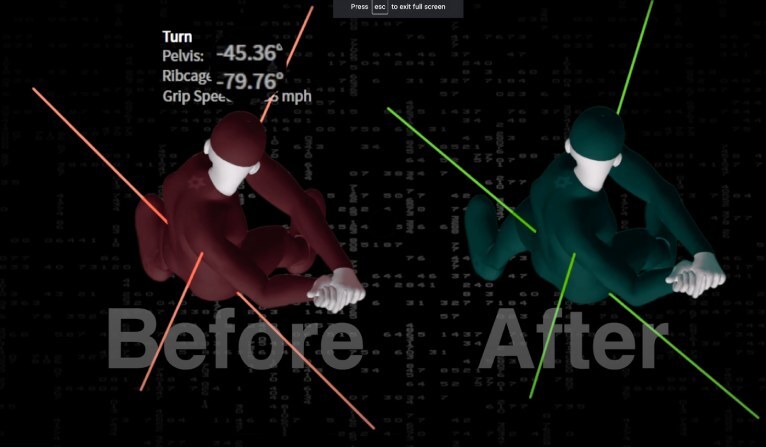
Shown above is a great example of why balanced rotation is better than just trying to increase your rotation.
You're looking at the before and after of an amateur golfer who is 63 years of age, and like most golfers over 50, he came to us looking to get back some of that speed lost to ‘Father Time.’
He was told that more rotation was the key to more speed, more rotation going back and more rotation coming down – and that's exactly what he worked on. You're looking at his first one (pictured on the left) that we captured, and this is him at the top of the swing.
At the top, he has turned 45 degrees with the hips, 80 with the chest, 114 with his shoulders. Those are great numbers for any age. Now, let's see if he was able to use that to his advantage.
So here he is at impact:

He was able to turn his hips 62 degrees during his downswing (from 45 closed at the top to 17 degrees open at impact).
As mentioned earlier, this is not ‘balanced’ at all. By that we mean, we see great players have equal amounts of rotation on both sides of impact, or they're favoring more open than they were closed.
So using our golfer here, as an example, his pelvis was 45 degrees closed at the top, meaning that he would need to be 45 degrees open at impact to be balanced. This would require him to turn 90 degrees in the same amount of time he was only able to turn 62 degrees.
Let’s examine the relationship between his rotation and swing speed to drive this point home: His clubhead speed on this seven iron swing was 84 miles an hour.
Looking at the swing he put up at the end of the lesson, he's now starting down a little less rotated than he was before, but his pelvis acceleration was increased because of his improved foot to ground connection.

These two factors helped him double his hip rotation from 17 degrees to 34 degrees open at impact, while adding 10 more degrees of rotation to his chest, while his shoulders went from two degrees closed to eight degrees open (shown in the bolded red and green lines).
What happened to his club head speed?
It jumped from 84 miles per hour to 92 miles per hour!
By improving his body angles in the backswing, we were able to improve his transition sequence, add more speed to the grip earlier, which allowed him to better balance out his rotation.
For his efforts, he was rewarded with eight more miles per hour of speed in a short amount of time.
Too often, we hear golfers given a choice to either:
1. Be passive with the arms and rotate; or
2. Pull the arms down, and stall all of your rotation.
That's a bogus choice because neither of those is good for your swing.
The goal should be to do what our golfer here just did. He got the grip into the club moving faster earlier and on plane, which allowed him and his words, “to turn through the ball like he had never felt before.”
SPEED KILLER #4 | DOWNSWING STRETCH
These two factors helped him double his hip rotation from 17 degrees to 34 degrees open at impact, while adding 10 more degrees of rotation to his chest, while his shoulders went from two degrees closed to eight degrees open (shown in the bolded red and green lines).
What happened to his club head speed?
It jumped from 84 miles per hour to 92 miles per hour!
By improving his body angles in the backswing, we were able to improve his transition sequence, add more speed to the grip earlier, which allowed him to better balance out his rotation.
For his efforts, he was rewarded with eight more miles per hour of speed in a short amount of time.
Too often, we hear golfers given a choice to either:
1. Be passive with the arms and rotate; or
2. Pull the arms down, and stall all of your rotation.
That's a bogus choice because neither of those is good for your swing.
The goal should be to do what our golfer here just did. He got the grip into the club moving faster earlier and on plane, which allowed him and his words, “to turn through the ball like he had never felt before.”
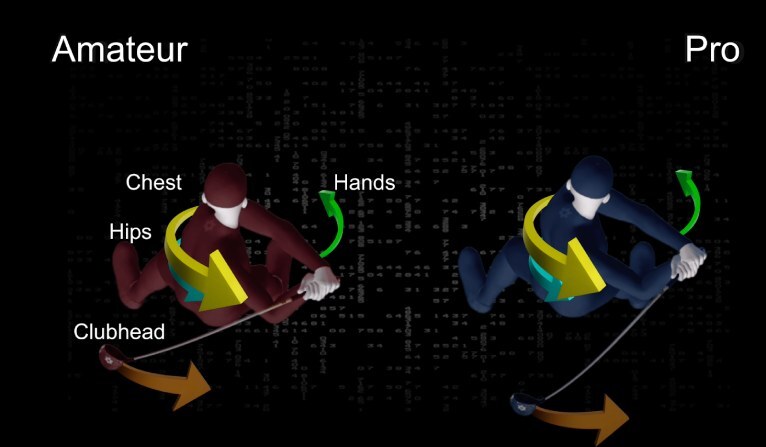
Have you ever been given the swing advice of, “firing the hips early” or “getting the lower body moving first, then the upper body?”
This last Speed Killer goes with our point number two (casting the knees) – which is the idea of holding the upper body still, creating a ‘X factor’ stretch in the downswing.
Golfers are now trying to hold the shoulders, fire the lower body, and try to increase the stretch between the two hemispheres of their golf swing.
The problem with that is that there's no time in the downswing for that to make sense.
At some point, the gap between the upper and the lower body needs to be closed, right? If you're increasing that stretch, as you start down, you're never going to have a chance to close that gap.
Not only will you lose speed, but as your body gets to this ‘hung back’ closed position, now you're affecting your release and how you hit it on the club face.
This one is killer – and it’s the opposite of what fast players do.
You need that entire quarter of a second to generate speed properly in your swing.
Our goal is to get the club moving as fast as we can as early as we can, and if you wait and try to catch up afterward, you're going to be robbing yourself on the business end of the club. We have mountains of 3D data that support this.
When the goal of the downswing is to basically go from zero miles per hour with the club head to a hundred plus miles per hour in less than a quarter of a second, it's probably a good idea to look at the acceleration profiles.
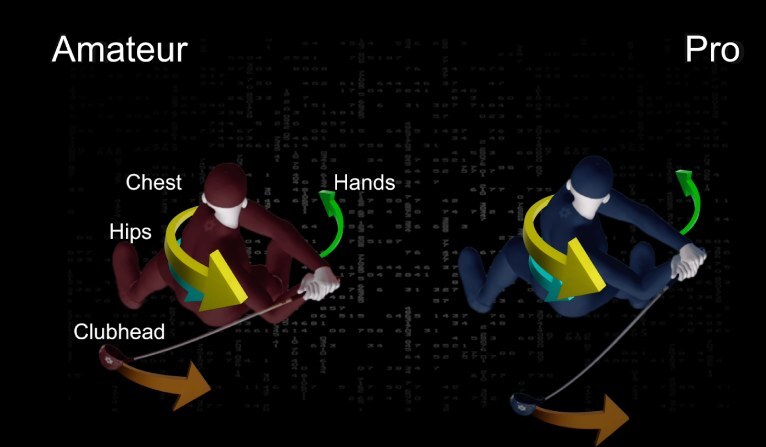
We can see how quickly the hips accelerate. We can see how quickly the chest accelerates. We can also see the same for the club. And lastly, we can see how fast the left arm accelerates in the downswing here.
You're looking at a different set of Pro and Amateur golfers which we’ll use to demonstrate what we commonly see with regards to acceleration.
We're using these two golfers because they represent a large data set, they have similar length backswings (pictured below), and they both rotate very well.
In fact, the Amateur rotates more and gets more open than the Pro does – but the big difference here is that the Pro has 25 more miles per hour in club head speed.
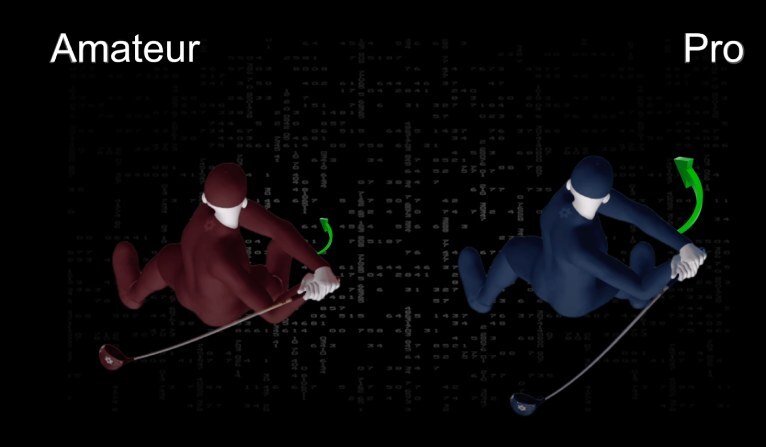
One common trait we see with fast golfers is they get their left arm moving faster than their hips, their chest, and the club very early in the downswing.
It's the opposite of being passive with the arms.
We see them have very strong accelerations from the top, because again, they're trying to get their club going from zero to over 120 miles an hour, in about 0.220 seconds…not really something you can do passively.
So what we're going to do is stop each of these golfers in their downswings when their left arm is accelerating faster than the club, the chest and the hips and freeze that frame for you:
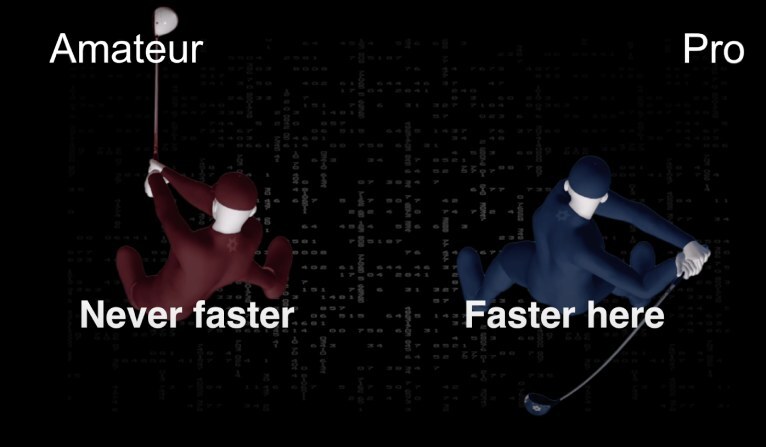
It didn't take our pro long to reach that spot; however, our Amatuer actually never gets his left arm accelerating faster than the other three, which was something he told us he was trying not to do. If you don’t get speed into the left arm, it never reaches the clubhead.
By the end of the lesson, we were able to help him change his concept, and most importantly, show him how to ramp up his acceleration and boost his swing speed.
Meet the Authors:
Mike Granato & Shaun Webb
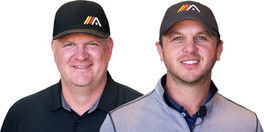
Shaun and Mike, Co-founders of Athletic Motion Golf, have reviewed THOUSANDS of swings from both PGA Pros and Amateurs of all skill levels inside of GEARS, their 3D motion capture software.
Shaun and Mike work with players from the PGA Tour, Champions Tour, European Tour, Korn Ferry Tour, LPGA Tour, and every level of amateur golfer – making them some of the top instructors in the industry.
The AMG Speed System
Discover AMG's most popular training system ever created.
The SPEED System will reveal the 12+mph of swing speed hiding inside of your right now!
YOUR GUIDE TO BOOSTING SWING SPEED
If you are looking for a step-by-step, proven path to increasing your swing speed, we’ve got you covered.
Click any of the buttons on this page to check out AMG’s most popular swing training ever, the AMG Speed System.
This training series will give you a step-by-step blueprint with the proven drills to not only cure these 4 Speed Killers outlined in this post, but also ALL of the evidence supporting our findings, the roadblocks to avoid, weekly drills and practice routines that do the teaching for you by committing these principles to muscle-memory, and much much more.
Your Nexts Steps for Adding INSANE Amounts of Swing Speed.
We know removing these speed killer will add speed to your swing.
But just like there are speed killers in your swing we must remove, there are also speed moves that we can instantly add to your swing to find additional speed!T
he AMG Speed System is out complete Step by Step speed boosting system that’s not only eliminates all of your speed killers…but also installs moves and swing technique that will instantly unlock speed you’re capable of right now.
Click the button that says ‘Discover More Speed' to see everything the Speed System has to offer, a d take advantage of a very special $100 Discount if you act today!
Consult your doctor prior to any training within our products, videos, or website. Nothing on this page, any of our websites, or any of our content or curriculum is a promise or guarantee of results, and we do not offer any legal, medical, tax or other professional advice. By using our training, you understand that the information in our products are based on our training experience only and is not professional medical advice.
